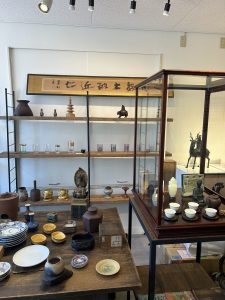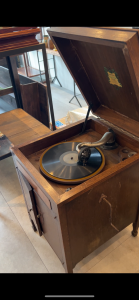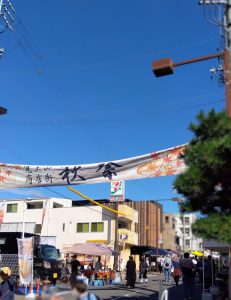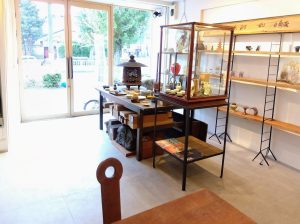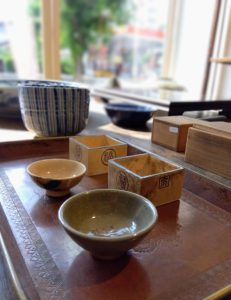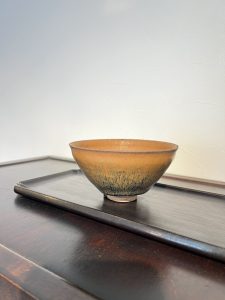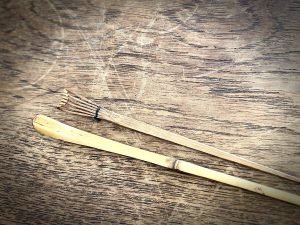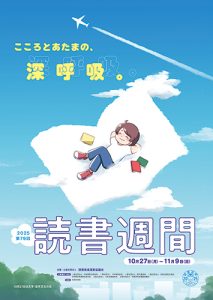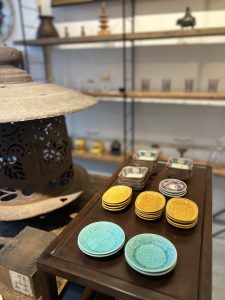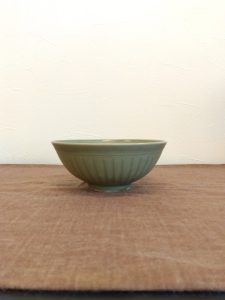「相続と骨董品買取のお話 その6」刀剣の買取のポイント(愛知県名古屋市千種区姫池通 骨董買取 古美術風光舎)
2025.11.04
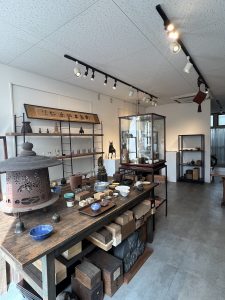
先日も買取させていただきましたが、遺品整理や生前整理や実家の片付けなどで刀剣がでてきてどうしたらいいですか?買取してもらえるか?などのご相談をよくお受けします。刀剣は、登録証など少々扱いに注意が必要だったり、その保存やその価値など扱いが難しいのでは?とのご相談も。
本日は、刀剣類を売却する際どのような点に注意点や、高く買取ってもらうためのポイントなどをあげてみましたので是非ご一読ください。
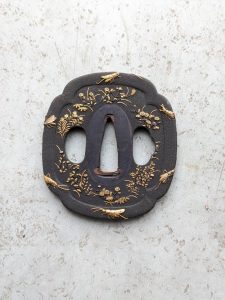
1.登録証はありますか?
まず、刀剣の売買には「鉄砲刀剣類登録証」が不可欠です。これは、銃刀法に基づき、所持を許可された証でして、この登録証がない刀剣の売買は法律違反となります。登録証は、刀の所有者情報や刀の形状、銘などが記載された重要な書類でして、売却前には登録証の有無、記載内容の正確性を必ず確認してください。
よく、親族様がその存在すら知らずに古い刀剣がでてきたりすることが多いのですが、登録証の紛失や破損した場合は、速やかに警察署への届け出と教育委員会への再発行手続きが必要となります。手続きの際は、刀剣と身分証明書、印鑑が必要になり、手続きの流れなどは管轄の警察署や教育委員会に確認をしてください。
また、登録証の有無、売買手続き、所有権の移転など、法律に違反しないよう注意が必要です。刀剣の売買には銃刀法などの法律に関する知識が不可欠ですし、違法な売買に関わると罰則が科せられる可能性がありますので、専門業者に相談することをおすすめいたします。
なお、手続きには一定の費用と時間がかかりますので、売却を検討する際には余裕を持って手続きを行ってください。
2、刀剣の状態とその価値は?
刀剣そのものの状態は査定額に大きく影響します。錆び、欠け、汚れなどがあると価値が大きく下がる可能性があります。とはいえ素人による洗浄はかえって状態を悪化させる可能性があるため、絶対に避けましょう。また、保管状態にも注意が必要ですので、湿気や直射日光を避け、専用の保管ケースなどで保管することが大切です。
査定前に状態を良くするためにできることは、乾いた布で優しく拭く程度でじゅうぶんです。
3.刀剣の付属品にも価値があります。
刀剣には刀身以外にも様々な付属品があります。刀装具と呼ばれるのですが、鍔(つば)、柄(つか)、はばき、目貫(めぬき)、笄(こうがい)、小柄(こづか)、縁頭(ふちがしら)、柄巻(つかまき)など。これらの刀装具は刀の価値を左右する重要な要素であり全て揃っている方が高額査定につながりますが、単品でも価値はあり売却は可能です。
また、刀を収納する箱や鞘なども、状態が良いほど査定額が高くつきますので、付属品の状態も事前に確認し、可能な限り綺麗に保管しておいてください。とはいえ、付属品が不足している場合は査定額に影響する可能性がありますので不安な点等はお気軽にご相談ください。
4.早期売却も検討に
先ほどの保存状態にも関係しますが、刀剣は経年劣化によって錆びや変色などが生じる可能性があります。状態が良いほど高価買取が期待できますので、保存等に自信がない、売却を検討しているなどの場合はできるだけ早い段階での売却がよろしいかと思われます。(状態が悪化すればするほど査定額は下がります。)
5、無銘刀の売却の場合
作者名などが不明な無銘刀でも、状態や作りによっては高額査定が期待できます。刀身の形状、長さ、反り、仕上げの技術、そして付属品などの状態が査定の重要なポイントになります。名刀と比べて価値が低いと考える方もいますが、希少価値の高い無銘刀も存在しますので、専門業者の査定により適切な価格での売却できる可能性もあります。
いかがだったでしょうか。
刀剣の売却を検討の際は、鉄砲刀剣類登録証の確認、付属品を揃えること、売却を検討・保存に自信がない場合は早期売却も重要かもしれません。
また売却の際は刀剣の状態、付属品の確認、銘の確認、法律的な注意点、安全な売却方法の選択、査定額への対応など、様々な点に注意を払う必要がありますので、実績があり、専門知識を持った信頼できる業者を選ぶようにしたいものです。また、専門業者へのご相談売却はスムーズで安心安全な取引や高額査定に繋がります。
古美術風光舎では、長年大切にされていた刀剣を次の持ち主様まで気持ちよくお譲りしたく存じます。刀剣の行先にお困りでしたら実績・専門知識のあります弊店へお気軽にご相談くださいませ。(スタッフY)
Recently, we purchased some items, but we often receive inquiries like: “What should I do if swords appear during estate cleanouts, pre-death organization, or clearing out my family home? Can you buy them?” We also get questions like: “Swords require some careful handling, like registration certificates, and aren’t they difficult to manage in terms of preservation and value?”
Today, we’ve listed key points to note when selling swords and tips for getting a higher purchase price. Please take a moment to read through them.
1. Do you have the registration certificate?
First, the “Firearms and Sword Registration Certificate” is essential for buying or selling swords. This certificate, issued under the Firearms and Sword Control Law, permits possession. Selling swords without this certificate is illegal. The registration certificate is a crucial document containing the owner’s information, the sword’s specifications, and the maker’s signature. Before selling, always confirm the certificate’s existence and the accuracy of its details.
It is common for relatives to discover old swords without even knowing the certificate existed. If the certificate is lost or damaged, you must promptly report it to the police station and apply for a reissue at the Board of Education. For the procedure, you will need the sword, your identification, and your personal seal. Please confirm the procedure flow with your local police station and Board of Education.
Additionally, careful attention is required to ensure compliance with the law regarding the certificate’s presence, sale procedures, and transfer of ownership. Knowledge of relevant laws, such as the Firearms and Sword Control Law, is essential for sword transactions. Involvement in illegal sales may result in penalties, so consulting a specialist dealer is recommended.
Please note that the procedures involve certain costs and take time. If you are considering a sale, allow sufficient time for the process.
2. What about the sword’s condition and its value?
The condition of the sword itself significantly impacts its appraisal value. Rust, chips, stains, etc., can substantially reduce its worth. However, cleaning by amateurs can worsen the condition, so this should be avoided at all costs. Careful storage is also crucial; avoid humidity and direct sunlight, and store it in a dedicated storage case.
Before appraisal, gently wiping it with a dry cloth is sufficient to improve its appearance.
3. Sword accessories also hold value.
Swords come with various accessories beyond the blade itself. These are called sword fittings (tōsōgu) and include the tsuba (guard), tsuka (handle), habaki (blade collar), menuki (decorative fittings), kogai (peg), kodukae (small fittings), fuchigashira (pommel), and tsukamaki (handle wrap). These fittings are crucial elements that influence a sword’s value. Having a complete set generally leads to a higher appraisal, but individual pieces also hold value and can be sold separately.
Additionally, the storage box and scabbard for the sword will fetch a higher appraisal price if they are in good condition. Therefore, please check the condition of the accessories beforehand and store them as cleanly as possible. That said, missing accessories may affect the appraisal value, so please feel free to consult us if you have any concerns.
4. Consider Selling Early
This relates to the preservation condition mentioned earlier. Swords can develop rust or discoloration due to aging. The better the condition, the higher the potential purchase price. If you lack confidence in proper storage or are considering selling, it is advisable to sell as early as possible. (The worse the condition deteriorates, the lower the appraisal value becomes.)
5. Selling Unmarked Swords
Even swords without a known maker’s name can command high valuations depending on their condition and craftsmanship. Key appraisal factors include the blade’s shape, length, curvature, finishing techniques, and the condition of any accessories. While some may assume their value is lower than famous swords, rare unmarked blades do exist. Having them appraised by a specialist increases the likelihood of selling them at a fair price.
How did you find this information?
When considering selling swords, it’s important to verify the Firearms and Sword Registration Certificate, gather any accessories, and if you’re unsure about selling or preserving the sword, selling it early might be wise.
Furthermore, when selling, you need to pay attention to various points: the sword’s condition, checking accessories, verifying the signature, legal considerations, choosing a safe selling method, and negotiating the appraisal value. Therefore, it’s best to choose a reputable dealer with proven experience and specialized knowledge. Consulting a specialist dealer for sale can lead to a smooth, secure transaction and potentially a higher appraisal value.
We wish to ensure swords cherished for years find their way to their next owner with care. If you are uncertain about a sword’s future, please feel free to consult Fūkosha, an antique dealer with proven experience and specialized knowledge.
*******************
ご実家の整理やお片付けなどをされている方のご相談などが多くございます。
お片付けなどくれぐれもご無理のないようになさってくださいませ。
風光舎では古美術品や骨董品の他にも絵画や宝石、趣味のお品など様々なジャンルのものを買受しております。
お片付けをされていて、こういうものでもいいのかしらと迷われているものでも、どうぞお気軽にご相談下さいませ。
また風光舎は、出張買取も強化しております。ご近所はもちろん、愛知県内、岐阜県、三重県その他の県へも出張いたします。
まずは、お電話お待ちしております。
愛知県名古屋市千種区姫池通
骨董 買取【古美術 風光舎 名古屋店】
TEL052(734)8444
10:00-18:00 OPEN

